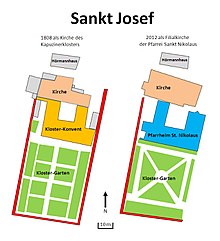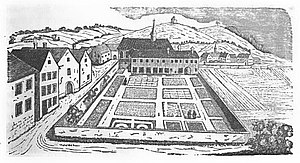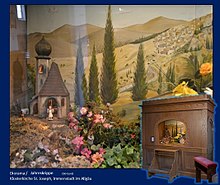St. Josef (Immenstadt)
Coordinates: 48 ° N , 10 ° E
St. Joseph in Immenstadt is the church of the former convent of the Capuchins in Immenstadt ( Oberallgäu in Bavaria ), the St. Joseph was consecrated. After the monastery was dissolved in 1980, the church fell to the Roman Catholic parish of St. Nicholas .
History of the monastery
→ primary source
prehistory
In 1645, Count Hugo von Königsegg decided to settle a Capuchin monastery in his residence town of Immenstadt in order to counteract the brutalization that was advancing through the chaos of war by “planting good deeds”. He asked the Guardian of the Capuchin Monastery of Lucerne to intercede with the Swiss provincial government. After their approval in 1646, two padres were sent to Immenstadt, who were initially housed in a private house near the Pfaffentor . The two Capuchins were not used to the harsh climate of the area and managed to get the order general to allow their withdrawal from Immenstadt. The count and the provincial leadership were not in a position to change the general of the order, especially since in 1647 the Swedes also plundered the city. It was not until 1650 that the monks returned to Immenstadt.
Monastery building
In 1652 the branch was established with the erection of a cross. Several houses, the chaplaincy, a school house and a farmstead were acquired and had to make way for the monastery building on the city wall and the churchyard. The monastery buildings were erected between 1653 and 1655. The construction costs amounted to 6,590 guilders.
Affiliation
Until 1668 the monastery belonged to the custody of Constance and thus to the Swiss province. Afterwards, Wangen and thus the province of Upper Austria were responsible. From 1782 the branch of the newly founded Swabian and from 1826 belonged to the Bavarian Province. In the description of the earth from 1838, the monastery is also described as the Capuchin Central Monastery .
Entertains
The monks were supported by Count Hugo von Königsegg-Rothenfels and the municipality of Immenstadt. Under Hugo they were entitled to two meals a week and a load of wine a year. Even Leopold Wilhelm von Koenigsegg-Rothenfels , the son of Count Hugo this tradition continued. The city supplied firewood and also wine. They were also allowed to collect yarn and groceries in the County of Königsegg-Rothenfels , the Hohenegg region and in the Kleinwalsertal . A 2,000 square meter walled monastery garden was attached to the monastery. To the east of it were about 5 hectares of fields belonging to the monastery, the so-called "Klosterösch".
beatification
On October 5, 1729, the beatification feast of the martyr Fidelis von Sigmaringen was held in the monastery church of St. Joseph . In 1730, the construction of a chapel began, which was given a relic of Fidelis on April 21, 1731 and consecrated to St. Fidelis, St. Clare and St. Francis on August 5, 1746 . A crypt for the deceased friars was laid out under the chapel.
Latin school
From 1781 onwards, several boys were taught the basics of Latin in the monastery. From 1787 these classes were expanded into a formal college, the successful completion of which entitles the student to transfer to an Austrian university or the higher grades of a Bavarian grammar school . A well-known student of this school was the author Aloys Adalbert Waibel, born in 1787 . With the end of the county in 1804, the operation of the college ended.
Library
In 1808, the monastery library contained 4,825 volumes. The collection grew to 5,100 books by 1898. A government collection of 2,800 copies was also available. During the Second World War, the monastery was confiscated by the Bavarian State Office for Monument Preservation . In addition to the most valuable holdings of the Darmstadt State Library , the library of the Bavarian National Museum in Immenstadt was also stored. In an air raid on April 29, 1945, one Capuchin woman and one Capuchin woman were killed and a fifth of the stocks destroyed. After the monastery was dissolved, the remaining books were taken to the Capuchin central library in Altötting. The best-known book in the collection was the volume “ Lessons on the Use of the Earth's Mirror ” by Father Franziscus Seraph from 1558.
Demolition of the monastery
In 1976 the Free State of Bavaria sold the monastery, including the church and garden, to the Catholic Parish Church Foundation. In August 1980 the Capuchins left the city. In 1984 the monastery convent had to give way to the new building of the parish center of St. Nicholas, which had been planned for some time. The monastery garden was redesigned and made accessible to the public. A sculpture by Willi Tannheimer in front of the entrance to the church still reminds of the Capuchins .
church
The construction of the church, located almost 100 meters north of the parish church, began in 1654; On October 21, 1655 it was consecrated by the Bishop of Constance, Franz Johann von Praßberg, to the Mother of God, St. Francis and St. Joseph. The builder was the Kleinwalsertaler Hans Mutter from Mittelberg.
On the north side a chapel dedicated to Saint Fidelis zu Sigmaringen was added in 1730 , under which the crypt of the Capuchins is embedded. The family crypt of the Counts of Königsegg is located in the church . On the epistle side of the high altar there is Count Hugo and all members of the count's family who died afterwards. Only Franz Fidel von Königsegg-Rothenfels was buried in the cemetery according to his will. The counts lie to the left and right of the high altar, the countesses between the women's altar and the Antonius altar. The height of the grave vault was six shoes , about 1.75 meters. The children of the count's family were buried under the communion bench.
In the middle of the 19th century, the crypt was filled in as part of a construction project. Some epitaphs are still present. A statue of Saint Anthony from 1771 was made by the sculptor Johann Richard Eberhard . In 1775, the Immenstadt universal talent Joseph Sebastian von Rittershausen created the high altar painting “English Greeting”. During the major redesign in 1861 and 1862, the altarpiece was replaced by the painting "Death of St. Joseph" by Ludwig Caspar Weiß . Weiss also illustrated the two side altars and also provided two landscapes in 1858. The designs for the confessionals, the high altar and the pulpit come from the Capuchin Servulus Gassenmaier, who died in Immenstadt in 1887 . The painted Holy Sepulcher was made by Johann Michael Herz from Immenstadt . In 1877 green became the dominant hue in the church. Johann Evangelist Fröschle made the ceiling frescoes of the Holy Trinity and the four evangelists based on designs by Andreas Merkle . In the large cross next to the entrance from 1843 there is a capsule with a certificate.
In 1903 the church was completely redesigned. The Fidelis chapel and the choir were enlarged and the top of the wall raised under the direction of master builder Christian Bufler . The west facade was redesigned according to a design by Hans Schurr in the neo-baroque style with a volute gable . The Capuchin brother Angelus Schnitzler renewed the three altarpieces. A vaulted wooden ceiling was drawn in. There you will find the 1904 painted three virtues of Immenstädters Ludwig Glötzle . In 1905 he also made the picture “Adoration of the Holy Lamb” on the choir arch. The church also got new stations of the cross and confessionals during this time. In 1930 and between 1962 and 1976, the church was redesigned in the areas of the altar frame, choir arch and gallery wall. In 1939 an organ from the Zeilhuber workshop was installed in old towns. The old bell in the turret was replaced by two smaller ones in 1993. The turret got an onion hood . The patronage is celebrated on March 19th .
organ
The organ was built in 1939 by the organ builder Zeilhuber (Altstädten). The pipe material from the previous organ, which was built in 1904 by the organ builders Gebr. Hindelang, was reused. The instrument has 19 registers on two manuals and a pedal and is arranged and voiced in the late romantic style.
|
|
|
|||||||||||||||||||||||||||||||||||||||||||||||||||||||||||||||||||||||||||||||||||||||||||||||||||||||||
- Coupling : II / I (also as sub- and super-octave coupling), I / P, II / P
Hörmannhaus
The Hörmannhaus , built in 1757 just north of the church, was given to the monastery in 1905. The building housed a bakery, then from 1957 to 1990 the local museum of local history and since 1993 a pottery. The house is a listed building.
Remarkable
- The Capuchin Church was vacant until 1806 . Asylum seekers were not allowed to be arrested there.
- During the great fire on the night of April 23rd to 24th, 1844, the roof of the monastery church caught fire several times, but could be saved with " exact need ".
- The Immenstadt Capuchin Monastery also served as a holiday and recreation monastery for the clergy of the province
- To the left of the entrance is a mechanical year nativity scene. If you put a 20 or 50 cent piece (previously a groschen) in the coin slot, the diorama is lit, the two wings of a chapel gate open and the young Jesus comes out with a blessing.
literature
- Johannes Staricius: Mysterious Hero's Treasure, or the Complete Egyptian Magical Shield . Cologne and Weimar 1750
- Sebastian Geiger: Physical-medical topography of K. Baier. District Court District Immenstadt in the Upper Danube District . Kempten 1819
- Calendar for Catholic Christians to the year 1848 . Sulzbach 1848
- Franz Joseph Heim (Ed.): Sermon Magazine, Volume 18 . Augsburg 1849
- Adalbert Waibel: The Empire königsegg-rothenfels and the rule Staufen ... . Kempten 1851
- JM Kennerknecht: History of the Capuchin monastery Immenstadt: 1645–1903 . Kempten 1903
- City of Immenstadt i. Allgäu (Hrsg.): Home book of the city Immenstadt i. Allgäu 1360-1960 . Immenstadt 1960
- Max Flad, Art Guide Immenstadt , ed. v. City of Immenstadt i. Allgäu, Kempten 1986
- City of Immenstadt i. Allgäu and Büro Janner (ed.): Immenstädter AltstadtSpaziergang . Immenstadt o. J.
- Werner Matthäus Schnell: Churches and chapels of the parish Immenstadt . Lindenberg 2009
- Rudolf Vogel (Ed.): Immenstadt im Allgäu . Landscape, history, society, economy, cultural and religious life over the centuries. Immenstadt im Allgäu 1996
Individual evidence
- ^ Rudolf Vogel (ed.): Immenstadt im Allgäu . Immenstadt im Allgäu 1996, ISBN 3-920269-00-4 , p. 444, 532-536 .
- ^ Joseph Anton Eisenmann: Description of the earth of the Kingdom of Bavaria according to its latest division from November 29, 1837 . Bamberg 1838, p. 278 .
- ^ Franz Joseph Heim (ed.): Predigt-Magazin, Volume 18 . Augsburg 1849, p. 7 .
- ↑ Aloys Adalbert Waibel: The imperial county of Königsegg-Rothenfels and the rule of Staufen . Kempten 1851, p. 122 .
- ↑ Johannes Staricius: Mysterious Hero Treasure, or the Complete Egyptian Magical Shield . Cologne and Weimar 1750, p. 513 .
- ↑ F. Pentner: Guide to Immenstadt and surroundings . Immenstadt 1889, p. 50 .
- ↑ Information on the organ ( Memento of the original from June 10, 2015 in the Internet Archive ) Info: The archive link was inserted automatically and has not yet been checked. Please check the original and archive link according to the instructions and then remove this notice. on the website of the church music Immenstadt
- ↑ Nürnberger Zeitung, Volumes 11-16 . Nuremberg 1844.
- ^ Weekly newspaper for the Land Commissariat districts Zweibrücken, Homburg and Cusel . 1844.
Web links
- Official Immenstadt website
- Immenstädter places of worship ( Memento from February 6, 2013 in the web archive archive.today )





